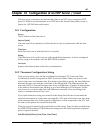
191
KIRK Wireless Server 600v3 Installation and Configuration Guide
Chapter 13 Configuration of the Update Server
It is possible to update the firmware and configuration of a large number of KIRK devices
in a distributed environment by automated means. This is done by storing the
configuration and firmware information on a standard Web server, which in turn is
called up the individual devices. There are two modules in the device which work in
tandem. The first is known as „UP0“ and actually executes the upload and download of
configuration information as well as the download of updated firmware. UP0 is
controlled by commands as detailed below. The second module is known as „UP1“. It
serves to poll a given website for changed configuration information. If certain conditions
are met, UP1 will issue commands to UP1 to perform the requested updates.
13.1 System Requirements
• One or more Web server(s) accessible by the devices.
• the Web servers tested were MS IIS and the Apache server. It should, however, also
work with all other common Web servers.
• For best results, the Web server should be able to manage a large number of
simultaneous HTTP sessions. MS Personal Web Server, for example, is not a suitable
Web server, since it manages a maximum of 10 simultaneous HTTP sessions.
13.2 Installation
To be able to transfer device configurations onto the Web server, the latter must allow
HTTP PUT requests. All other functions require HTTP GET authorisation. Since all HTTP
requests are executed unauthenticated, the Web server must allow anonymous reading
and possibly also anonymous writing. To allow HTTP PUT commands on a MS IIS, the
read and write check box must be enabled in the configuration of the relevant virtual
directory.
13.3 Configuration
See Configuration/General/Update to se how the URL parameter is configured. Note
that the URL parameter must point precisely to the location of the file with the contained
maintenance commands. It is also to be noted that this URL (just like all other URLs used
by KIRK devices) does not support host names. Therefore, a valid IP address always has
to be specified.
If the URL happens to end with a ‘/’, then a standard file name based on the product
description is used. If, for example, the URL is http://1.2.3.4/ configs/ , then it is extended
in the case of an IP1200 as follows: http:// 1.2.3.4/configs/update-ip1200.htm. The file
extension is irrelevant here. The extension *.txt or *.htm or no file extension at all is
possible. In relation to URL specifications, note that some Web servers differentiate
between upper case and lower case letters.


















